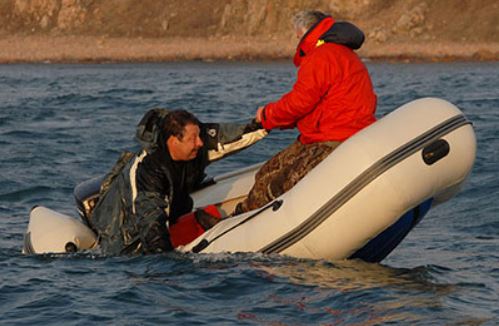My immediate thought when I heard about inflatable kayaks was more of a pool toy than an actual solid watercraft. Surely, they wouldn’t be able to stand up against a hardshell kayak, and are these inflatable kayaks even safe enough to get on the water?
Are inflatable kayaks safe? Are they good enough to be taken out on waters? This question is something that many people have asked, and we will answer it in this article. We will also break down the ins and outs of an inflatable kayak to show why they are as good (if not better) than their rigid brethren.

- Inflatable Kayaks (How Safe Are Inflatable Kayaks)
- Are Inflatable Kayaks Durable
- Can An Inflatable Kayak Get Punctured
- Are Inflatable Kayaks Stable & Rigid
- Can An Inflatable Kayak Sink
- What If My Inflatable Kayak Gets Filled With Water
- Performance On The Water
- Are They Suitable For All Age Groups
- Are Inflatable Kayaks Slow
- Do These Track Well
- Inflatable Kayaks Safety Tips
Inflatable Kayaks (How Safe Are Inflatable Kayaks)
Inflatable kayaks are incredibly durable. They’re built to withstand tough conditions, despite what some people think about them being flimsy and easy to get punctured.
Sitting in an inflatable kayak is not as stable and secure feeling as having a solid boat, but it will still feel stable and supportive. Even though they might not be suitable for every situation, they’re great for beginners or experienced paddlers looking for something new.
Check Out: Best Inflatable Kayaks
Are Inflatable Kayaks Durable
An inflatable kayak is a different tool than your typical pool toy. While some have just one layer of thin material, these are made with multiple layers of thick-coated materials. Some of the inflatables even feature an aluminum frame for better structure and stability.
These tough and durable vinyl or polyester-based materials can withstand being banged up by rocks in rocky waters or even the soles on your street shoes when you’re stepping into it to get in. You won’t damage them as easily.
When it comes to the life expectancy of an inflatable kayak, they are built very toughly. They’re not going to wear out anywhere near as fast as other conventional inflatables. Still, you should take care when transporting and refrain from dragging them.
Can An Inflatable Kayak Get Punctured
Modern inflatable kayaks are designed to be durable and puncture-resistant. So, you can rest easy knowing that even if you brush up against a rock or tree branch it won’t cause any harm.
But of course, the exception is always there, there is still the possibility of small tears happening in your boat’s seams which could lead to air leakage. The biggest danger lies with sharp rocks hitting just right; these will definitely leave damaging holes on your kayak so watch out for them along the shoreline.
When paddling in an inflatable kayak, punctures can happen. It’s not very common but it is a good idea to take that into consideration when storing away from sharp objects and using caution while transporting them. If you are careful with your boat then it should survive without any ruptures or leaks at all. Sometimes small patch kits come along which makes repairing the damage fairly easy too.
Are Inflatable Kayaks Stable & Rigid
After proper inflation, inflatable kayaks become remarkably stiff. They usually do not feel much different from regular hard-shell kayaks when you’re trying to stand in it or sit on the seat while paddling.
An inflatable kayak can be as strong and rigid as a hardshell one once it’s fully inflated. Make sure your boat is filled up all the way before you go on an adventure! However, a partially inflated kayak is difficult to keep afloat and not very effective at paddling through the water.
Inflatable kayaks are unique in that most of them use either inflatable chambers or a metal framework to act as rigid stabilizers. These features turn the boat into one of the most stable and firm types available.
Whether you plan on white water rafting or kayaking, make sure your inflatable has the capacity to handle the whitewater rapids.
Can An Inflatable Kayak Sink

The buoyancy of inflatable kayaks is incredible. They have multiple air tubes, which are filled with air before use for increased stability and safety on the water. Inflatable tubes are capable of keeping you afloat even if you capsize, which makes them harder to sink.
On average, inflatable kayaks have 3 or more separate air chambers. If you happen to get a leak in one of the air chambers, there are still two others that will stay inflated and keep you above water till you reach the shore and do the repair process.
What If My Inflatable Kayak Gets Filled With Water
Inflatable kayaks are likely to fill up with water easily because there isn’t an enclosed cockpit like hardshell kayaks have. Most of the whitewater inflatable kayaks are self-bailing and have holes in the seams, which allow any excess to drain out quickly.
Performance On The Water
People who love kayaking on water that is filled with rocks and rapids will enjoy inflatable whitewater kayaks. These boats are stable, track well across the river, and allow you to maneuver quickly when needed.
Are They Suitable For All Age Groups
Lightweight, stability, and ease of use make inflatable kayaks suitable for people of all ages. If an aged person or a small child is going to handle the kayak, I would always suggest preferring smaller and lighter models. Smaller, lighter kayaks are easier to paddle around in which is ideal for those who may not have as much energy or strength.
Are Inflatable Kayaks Slow
Inflatable kayaks are extremely lightweight in comparison to their solid counterparts. This makes them very convenient, but less than ideal for safety reasons. Any strong current or wind will make it hard for you to stay afloat and control your vessel, due to the fact that they can be thrown around easily by these forces of nature.
Do These Track Well
If you’re ever in a situation where your boat needs to go straight, it will be hard because of the lightweight and thick inflatable tubes. This is not too much of a problem, but if you need precision or are navigating through obstacles like rocks then this can pose an issue for rowers who want perfection when paddling on the water.
However, high-end inflatable kayaks are changing the game. The modern technology used in these hyper-light and durable boats, such as Sea Eagle Razorlight.
Inflatable Kayaks Safety Tips
Inflatable kayaks are durable but not invincible. You still need to take precautions when on the water, just like you would in any other type of kayak.
- If you don’t want your inflatable kayak to be sluggish, make sure it’s full of air.
- Check for any leaks if, after inflation.
- When loading your kayak, make sure the weight is evenly distributed. Having too much in one end could lead to tipping over or being harder for you to control when paddling forward.
- It is always best to be safe than sorry. That’s why even if you are a good swimmer it’s important that you wear life jackets. Check: Best Kayaking PFD
- Try to stay within safe water limits
- If you see a big wave coming towards you, try not to take it sideways as there is a chance of tipping over.
- Be careful not to drag your inflatable kayak over rocks and gravel, as that can puncture the material. You should also avoid running into sharp objects such as branches or trees with hard surfaces which could cause damage to either you or your boat.
- When kayaking, make sure you have a buddy with you or tell someone where your planned route is.
- Try to bring water, a sun screen, a hat, a whistle and most important your cellphone.
